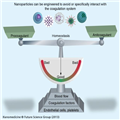Abstract and Introduction
Abstract
Nanotechnology is proven to provide certain benefits in drug delivery by improving solubility, increasing uptake to target sites and changing pharmacokinetics profiles of traditional drugs. Since properties of many materials change tremendously at the nanoscale levels, nanotechnology is also being explored in various industrial applications. As such, nanoparticles are rapidly entering various areas of industry, biology and medicine. The benefits of using nanotechnology for industrial and biomedical applications are often tempered by concerns about the safety of these new materials. One such area of concern includes their effect on the immune system. While nanoparticle interactions with various constituents of the immune system have been reviewed before, little attention was given to nanoparticle effects on the blood coagulation system. Nanoparticle interface with the blood coagulation system may lead to either benefits to the host or adverse reactions. This article reviews recent advances in our understanding of nanoparticle interactions with plasma coagulation factors, platelets, endothelial cells and leukocytes. Part I is focused on desirable interactions between nanoparticles and the coagulation system, and discusses benefits of using nanotechnology to intervene in coagulation disorders. Undesirable interactions posing safety concerns are covered in part II, which will be published in the June issue of Nanomedicine.
Introduction
Nanotechnology is rapidly finding expanding applications in various areas of industry (e.g., semiconductors, computers and engineering),[1,2] environmental sciences (e.g., water purification, and pathogen detection and identification),[3–5] food sciences (e.g., sterilization and prolonged shelf-life),[6–8] biology (in vitro diagnostics) and medicine (drug delivery and imaging).[9] There are also increasing levels of nanoparticles in the environment due to natural processes (e.g., volcanic eruptions) and industrial pollution (e.g., combustion byproducts, carbon black and urban particulate matters). In medicine, nanotechnology is being used to deliver drugs and imaging agents, helping to improve solubility, change pharmacokinetic profiles and increase uptake to target sites. Through these mechanisms, nanotechnology-based delivery platforms increase drug or imaging efficacy while lowering doses and decreasing side effects. However, the benefits of nanotechnology drug delivery platforms are often tempered by concerns about the safety of these materials. Specific areas of concern include carcinogencitiy, teratogenicity, developmental toxicity, acute toxicity and interaction with components of the immune system.
While the general immunotoxicity of nanoparticles has been reviewed before,[10–13] nanoparticle effects on the blood coagulation system have not been reviewed in detail. The purpose of this review is to fill this gap by providing an overview of the blood coagulation system and discussing recent advances in our understanding of the role of nanoparticle physicochemical properties in determining interactions with components of the coagulation system. Due to the complexity of this system and the growing number of examples demonstrating untraditional mechanisms unique to engineered nanomaterials, we structure the review to first provide a general overview of the coagulation system and its role in vascular physiology and pathology, then we discuss current knowledge about nanomaterial interactions with various elements of this system, and last, wherever data is available, we link nanoparticle-mediated effects on the coagulation system to pathophysiological changes following the exposure to engineered nanomaterials.
Nanoparticles can be engineered to either specifically interact with the coagulation system or to avoid such interactions (Figure 1). Nanoparticle effects on the coagulation system can be beneficial or adverse, depending on whether they are desirable or not. The first part of our review discusses examples of desirable nanoparticle effects on the coagulation system and how manipulation of nanoparticle properties may help to overcome coagulation-mediated toxicities and improve treatment of coagulation disorders. We will categorize coagulopathies based on their mechanism of action. Adverse interactions between various types of engineered nanomaterials and the blood coagulation system will be discussed in part II, which will be published in the June issue of Nanomedicine.[14]
Figure 1.
Nanoparticle interaction with the coagulation system.
Various components of the coagulation system (blood flow, coagulation factors, endothelial cells and platelets) work in concert to balance pro- and anti-coagulant processes and maintain homeostasis. Nanoparticles can be engineered to either avoid interaction with components of the coagulation system or to specifically interact with it. Nanoparticle effects on the coagulation system can be good or bad depending on their desirability. A delicate balance between pro- and anti-coagulant activities is required, and any shift in this balance leads to pathological processes (e.g., hemorrhage or thrombosis). Understanding nanoparticle interactions with the coagulation system is an essential part of establishing nanoparticle safety profiles.
Nanomedicine. 2013;8(5):773-84. © 2013 Future Medicine Ltd.











